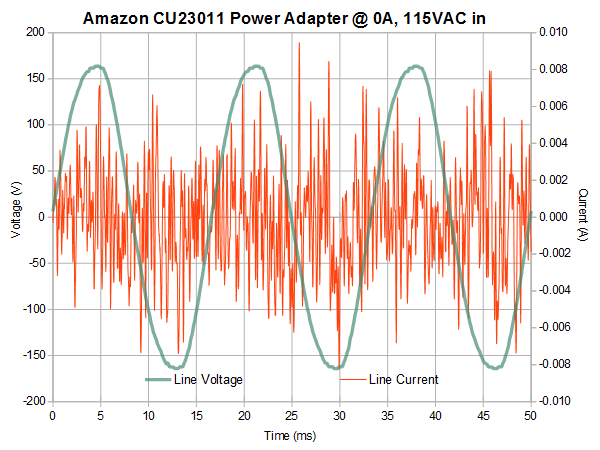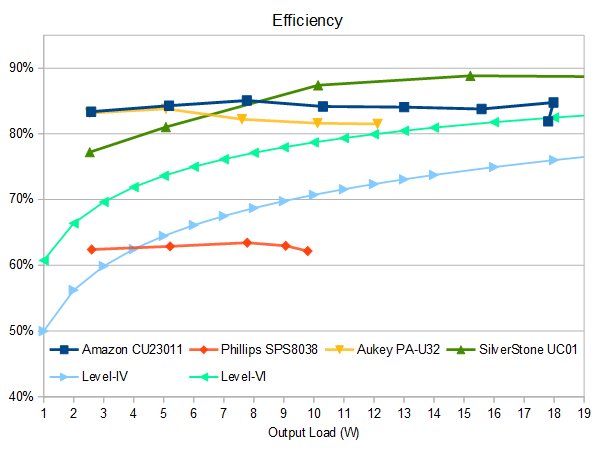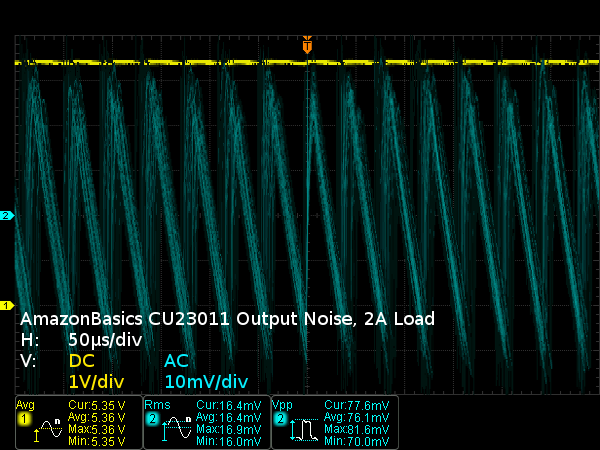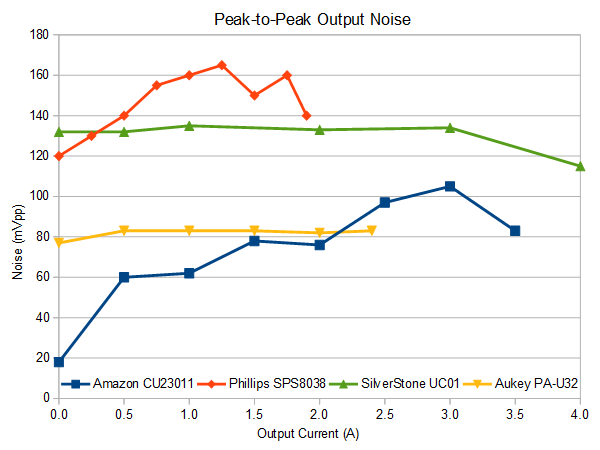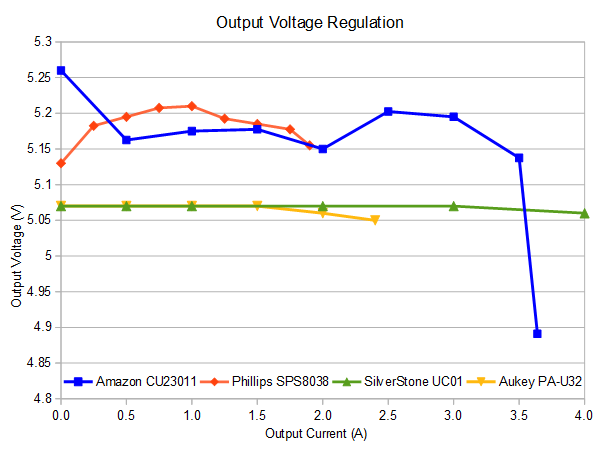AmazonBasics CU23011W Tap-Adapter: Top Performance, Imperfect Design
Cap On Stilts
Output filtering is handled by a proper 1nF X1Y1-class (8kV non-repetitive peak) capacitor and a trio of 560µF 6.3V polymer capacitors, one sitting between the two ports and the other two in the corner. There is enough space on both sides of the right capacitor to be flush with the board, so why isn’t it flush with the board?
Mechanical Interference
Whoever designed the capacitor footprints made them slightly smaller than the capacitors, and also failed to account for sleeving on the transformer’s secondary wires when placing their holes. Now we have the capacitor attempting to occupy the same physical space as the white wire’s insulation, preventing the capacitor from sitting flush.
This could have been avoided by either shifting the synchronous rectifier on the bottom away by half a millimeter or replacing the unused diode footprints with a slightly smaller copper-pour heat sink for the JouleWatt chip and tweaking the hole’s location accordingly.
Refresher
If you forgot about the size difference between a regular 1kV capacitor and a Y-class one, here’s a refresher. The last (and only) time I showed two of these side by side, they were of different nominal values. This time around, though, they are both “102” codes, meaning 1nF. The proper Y-class capacitor is about four times as thick and 50% wider in diameter for a total of eight to 10 times bigger by volume.
All of that internal redundancy with increased safety margins comes at a hefty premium in terms of volumetric density.
The Show-Runner
At the heart of Amazon’s CU23011W, we find a Chipown PN8386. This is the manufacturer’s top-of-the-line monolithic universal input converter. It features an internal startup bias circuit, a 1.6Ω 650V FET, it claims to enable standby power as low as 30mW, and it's intended for output power up to 18W (3.6A at 5V).
Apart from the prong attachment concerns, this adapter appears to have all the right parts and design precautions necessary to safely deliver the expected 3.4A and Level VI efficiency.
Get Tom's Hardware's best news and in-depth reviews, straight to your inbox.
Standby Power
Since the adapter has 30µF of input filtering and very low standby power, its top-off current peak near each voltage peak gets lost in the noise as far as we can see. Thankfully, calculating power by integrating v(t)i(t) cancels out the noise and yields an input power of 36mW. That's pretty close to Chipown’s sub-30mW claim, especially if you account for the red LED and its 3kΩ current-limiting resistor drawing about 1mA. That’s 5mW in output power.
Efficiency
Among the single-stage adapters that have survived my gauntlet and earned a pass, Amazon’s CU23011W takes the efficiency lead up through 8W and holds on to second place (while also beating Level VI efficiency) until 18W. Aiming for a cut-off voltage of 4.75, its output current eventually stabilizes at 3.64A (240mA overload), where its efficiency can be forgiven for dipping below the curve.
I tested the CU23011W fully buttoned up in its enclosure, so it didn't get receive a convection cooling bonus. Even after several minutes at 3.5-3.65A, the unit had barely warmed up.
Output Noise Waveform
When measuring output noise, I rarely get to use my oscilloscope's 10mV vertical scale for long. Amazon’s CU23011W is an exception, allowing me to continue using this scale at up to 2A output load. At 15 switching cycles spanning 600µs, we get a surprisingly low operating frequency of 25 kHz, which increases to 40 kHz by 3A output.
Why modulate the pulse frequency instead of the pulse width? Switching losses are incurred whenever the switch is in a transient state between fully on and off in either direction, regardless of on-time. Modulating frequency to maximize on-time and energy transfer per cycle reduces overall losses. It is a common trick in high-efficiency/low-power converters.
Peak-to-Peak Output Noise
Having three polymer capacitors and a monolithic synchronous rectifier works wonders for the CU23011W’s peak-to-peak noise, making it the new benchmark in this test.
RMS Output Noise
In the RMS noise department, Amazon’s adapter beats SilverStone’s for the first two data points, then trades places for the rest of our chart. I’m not going to complain about anything under 20mVRMS since device current draw transients combined with cable resistance can easily add considerably more than this.
Output Voltage Regulation
Output voltage is well within the acceptable range, though it's a little high in an unloaded condition. That's a side-effect of using primary-side sensing, where the controller periodically needs to activate just to detect whether a load got connected. While Amazon’s adapter may rival Phillips' for output regulation non-flatness, part of the CU23011W’s upward output voltage trend is courtesy of the Chipown PN8386’s 3% cable loss compensation doing exactly what it is supposed to do.
-
Daniel Sauvageau Readers wanted a break from generic no-name adapters. Here's something a little different.Reply -
Daniel Sauvageau Reply
They always are. Only one transformer, so no independent regulation. Only one transformer secondary and only one synchronous rectifier, so no isolation between outputs. No electronic fuses or PPTCs either, not really a problem when output current is only 4A with limited duty cycle.20964213 said:you never let us know if the two outputs where indeed connected in parallel.
I doubt we'll be seeing independently regulated 5V outputs in any adapter. At most, we might get a DC-DC converter in QC/USB-PD adapters with some fixed 5V ports. -
ElectrO_90 Americans and the use of Metric... doesn't compute! I need my 7/87ths of a inch measurement ;)Reply -
Daniel Sauvageau Reply
I'm Canadian :)20965184 said:Americans and the use of Metric... doesn't compute! I need my 7/87ths of a inch measurement ;) -
Onus I really enjoy these teardowns. Between you & Aris, it keeps my inner geek well-fed. When I buy a multi-socket adapter of most any kind, often it is to put somewhere, plug in devices that wouldn't fit otherwise, and just leave it, so I'm less concerned about the physical wear issues than a frequent-plugger might be.Reply -
zodiacfml It's not bad till that wiggly part. It will just not pass much current. This will burn soon when used in the kitchen.Reply
I have an extension cord with USB charging ports and six AC outlets, it just costs a bit more but certainly safer, convenient, and can pass more current. -
froozeball Wonderful dissection as always Sir!Reply
It's like watching Auguste Dupin or Sherlock Holmes unravel the threads in a mystery, forming an inescapable conclusion.
Thanks for putting this type of product on my radar M. Sauvageau!




